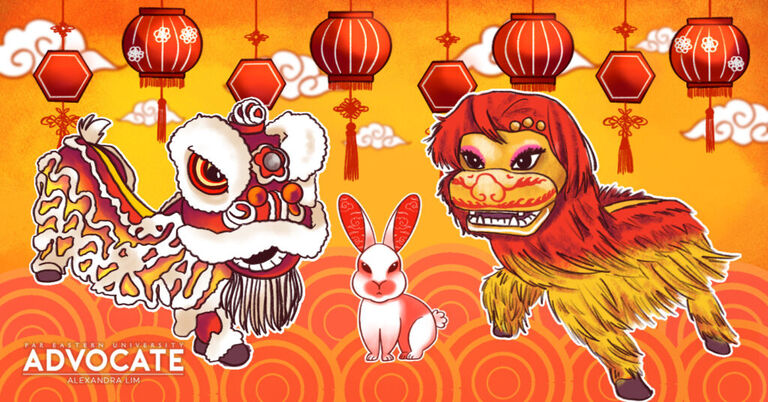
FEU opens season 85 campaign with tight loss against AdMU
- October 02, 2022 12:02
FEU Advocate
January 22, 2023 08:24

By Ma. Emilia Nicole D. Bertulfo & Nichola D. Gayle Manguerra
Other than being resilient and hospitable, Filipinos are known for their strong sense of religiousness and adherence to cultural beliefs – both superstitious, as well as keeping traditions from generation to generation. As a territory widely influenced by other nations that colonized the country decades ago, celebrating Lunar New Year to welcome the year with prosperity is no exemption to the consistent practice of congeniality and acceptance of the Filipino people.
From opening bright lights to welcoming luck and decorating the house with displays of animals or charms attracting good fortune, here are some customary beliefs Tamaraws partake in during the Chinese New Year.
The world’s oldest Chinatown resides in Binondo, Manila, where the heart of authentic Chinese culture in this diverse and multicultural country is kept alive.
In this renowned Filipino-Chinese district, you will be immersed in the most historical and traditional cultural heritage that promotes commerce and tourism in these modern times.
During the 1590s, the Spaniards established Chinatown for Catholic Chinese immigrants. 400 years later, it has been the place for businesses and business owners to make their craft flourish.
If you are a foodie at heart exploring traditional palatable flavors or a food enthusiast who takes risks for food fusion and experimentation, Chinatown’s diverse delectable food offering will surely satisfy your cravings and appetite.
In the streets of Ongpin, Binondo, various authentic Chinese food chains and stalls line up, selling items such as dumplings, hakao, succulent thick noodles, sweet tikoy rice cakes, steam buns (siopao), and braised pork.
For Joaquina Lakeish Dy, a 4th Year Human Settlement student who lived and studied in Binondo recommended an authentic Chinese go-to restaurant.
“Noong elem to high school, madalas ako nasa Binondo at doon din ako dati nakatira so masaya and masarap mga pagkain doon, you should try ‘yung pork chop noodles sa Tasty, Binondo (From elementary to high school, I was frequently in Binondo before and even lived there, it was fun there and the food were delicious, you should try Tasty’s pork chop noodles there),” she expressed.
Similarly, 4th Year BS Architecture student Han Chun Huang shared that Binondo’s Chinatown perfectly reflects the rich, culturally vibrant Chinese traditions with the food stalls lined up within every street and its traditional equipment utilized in cooking.
No Chinese New Year celebration will be complete without stuffing yourself with loads of authentic freshly-made Chinese goodies.
The bucket list continues by going around the must-visit attractions such as the Chinatown Museum displaying a glimpse of World War II through 18 galleries, visiting the famous astrology and fortune-telling store for some feng shui and Chinese Zodiac sign horoscope reading, and trying the Beijing foot spa with their Ventoza and Guasha massage services.
2. Loud and fiery fireworks, driving evil spirits away
As the most traditional and celebrated festivity in Chinese culture, the holiday starter during this Spring Festival begins by setting off fireworks and firecrackers to scare off unwanted spirits and to signal the beginning of a bright and prosperous new year.
The festivities would not be complete without the major custom of launching fireworks to celebrate the New Year at the stroke of midnight. It is believed that the person tasked with launching the first fireworks will have good luck.
Based on the legendary story, a monster known as Nian (meaning year) comes out on each New Year’s Eve to eat villagers and destroy their homes and crops.
When they learned Nian was afraid of fire and loud sounds, the villagers then discovered burning dry bamboo, which produced a loud noise nuisance with its piles of red paper shreds.
Starting this tradition then, Nian never came back, and the launching of fireworks became a tradition celebrated annually.
“Kailangan maingay ‘yung bahay kahit gabi, kailangan talaga maingay and then dapat ‘yung mga lights open kasi kailangan pumasok ‘yung swerte (At night during Chinese New Year, loud noises are needed and lights should be opened for luck),” 1st Year BS Accountancy Chinese student Hazel Iris Cai shared.
Many generations have passed, but setting off fireworks during Chinese New Year remains a symbolic tradition practiced up to this day not only to enhance the festive atmosphere but to dispel bad luck.
3. Lion and dragon dances, roaring symbols of good luck
While 2023 marks the Year of the Rabbit, the lions and dragons take center stage in traditional Chinese culture every year.
The eye-dotting ceremony, which includes dances for these widely known creatures, is a performance during the festive occasion to drive away evil spirits and embrace prosperous times ahead.
The lion is a symbol of stability, strength, and superiority, while the dragon is a representation of boldness, excellence, and power.
The former is more popular than the latter, but both dances feature individuals with expertise in martial arts dressed in vibrant costumes. Both of these traditions were first dated to the Han Dynasty (206 BC - 220 AD) in China.
The dragon dance may require more than two performers, with the dragon's body perched atop the poles, lifted up in the air. With the length and hefty weight of the dragon, smooth footwork and coordination are necessitated for the imitation of the mythical animal’s snaking motion.
Two dance performers “feed” the lion with lettuce during the event, as the word sounds like “wealth” in Chinese characters. The lion will then eat and spit this out for prosperity. It is accompanied by clashing cymbals, resounding gongs, and the music of beating drums.
Many folklore tales linger on the origins of how the lion dance came to fruition. According to one legend, the monster Nian terrorized villages, and a lion defeated and chased them. Villagers feared its return. With no lion to protect its people, they used a lion costume to drive away the monster.
4. Chinese food, a red knot tying familial bonds
Food is certainly one way to gather up a family as shared conversations and moments of being together are relished in its presence.
In an interview with FEU Advocate, Tamaraws who partake in Lunar New Year traditions from different year levels were asked of their routinely food eaten during the holiday. Among their many answers, eating noodles to lengthen one’s life span takes its rightful place as the most distinguished food eaten during the Lunar New Year.
Other than the aforementioned dish, sticky rice balls and steamed fish was also a frequent response to their favorite food provided during the holiday. While sticky rice balls are served to draw togetherness within a household, steamed fish is eaten for prosperity.
According to 3rd Year Business Administration student Jingyi Shi, serving steamed fish and eating only half of it signifies that the prosperity they received that year would remain, while the other half would symbolize the welcoming of better luck for the upcoming year.
Shi, who has been celebrating Chinese New Year traditions since she was a child, elaborated that the belief of serving steamed fish bringing fortune stemmed from the fact that when translated in Chinese, the characters of the words fish and abundance closely resemble one another.
While it is true that certain dishes and customs like these are done for the sake of tradition to some, its result of bonding relationships to flourish and strengthen is quite the additional treat. As for the luck these traditions bring? Well, one can merely think of it as a bonus.
5. Superstitious beliefs, practices passed from different eras
Even when it isn’t Lunar New Year, many Filipinos exercise their superstitious beliefs as believing it is better than not doing it at all with nothing to lose. After all, most of these were practiced by their ancestors or those before them.
In order to fend off bad luck, many superstitious beliefs were being practiced by the Tamaraws such as keeping the lights open all throughout the celebration of Lunar New Year, ensuring that no corner of the household is quiet and avoiding the use of darked colored clothes.
While some of these superstitious beliefs were generational chalices from previous generations, there are also Tamaraws who partake in them simply because their parents asked them to.
“Maggugupit kami ng chunk of hair and magbibigay kami ng ampao and may pinapakain din si mama na parang candy na inalay kasi swerte raw (We will cut a chunk of hair and give ampao and also my mom would give us candy to eat that is a peace offering because it brings good luck..)” Dy further said.
These practices done by FEU Tamaraws who participate in Chinese New Year festivities is an exemplary reminder to students to pay respect and give honor to their own heritage and origins, no matter how different they may be.
The beautiful fusion of intercultural traditions and Filipino-Chinese heritage is indeed worth celebrating, with its deeply embedded ties that will endure for generations to come.
Chinese New Year’s vibrant festivity, along with its traditions and customs, may change over time and go beyond its geographical outlier or Chinese diaspora, but its heart will always remain centered on the people.
The feeling of belongingness, with its intimate gatherings and strong sense of familial togetherness, keeps such traditions persistently alive. The celebration of Chinese New Year in the country inspires precisely this – a renewed sense of optimism for a chance to turn the page at the start of the year with a brighter and more prosperous 2023 ahead.








